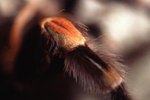
When exercising the most time-honored strategy for controlling cockroaches -- smacking them with a shoe or rolled newspaper -- you’re convinced they’re psychic. They seem capable of interpreting your movements as they successfully avoid your efforts to flatten their flat bodies. These insects have anatomy designed for success, and that includes their vision. They not only have eyes, but they have simple and compound eyes that provide a nearly 360-degree field of vision that includes you and your swatting shoe.
Roach Eyes
Roaches have two types of eyes: simple and compound. The smaller, simple eyes detect dark and light while the considerably larger compound eyes wrap around the head, allowing them to see attacks from all sides. Unlike human eyes that see color, shape and fine details with single lenses, the compound eyes of cockroaches consist of more than 2,000 individual lenses. They are sensitive to daylight, they don’t like red light and prefer to be active in the dark.
Multiple Lenses
Children familiar with bug-eye lenses have experienced looking at the world through 24 to 48 tiny hexagonal lenses at once. Each individual lens captures a slightly different image from the surrounding space. While disorienting to humans, cockroaches rely upon the different images. Madagascar hissing cockroaches have up to 2,500 hexagonal lenses in each compound eye, guaranteeing them both exceptional vision and an excellent awareness of what is happening around them.
Wrapped Eyes

Compound eyes of cockroaches wrap around the side of their heads distributing the lenses laterally making it possible to see motion from nearly all sides of their bodies at the same time without turning their heads. Cockroach heads are flat and the eyes wrap on the top as well as the sides, giving them a full view of potential predators.
More Than the Eyes

In addition to cockroach vision, their bodies rely upon a wide range of senses for survival, locating food and tracking pheromone scents. The six legs of cockroaches have organs that work in conjunction with the antennae to heighten their sense of touch, pressure changes and smell. Two fine hair-like adaptations on the rear portion of their abdomens, called cerci, act to sense slight breezes or vibrations. It’s no wonder that cockroaches can quickly detect the presence of humans and other predators in time to escape harm.
References
- Insect Science: Fine Structural Description of the Compound Eye of the Madagascar "Hissing Cockroach" Gromphadorhina Portentosa (Dictyoperta: Blaberidae)
- Insect Expert PhD: Cockroaches
- Invertebrate Anatomy Online: Periplaneta Americana, American Cockroach
- Orkin: Cockroach Anatomy
- Planet Cockroach: Know Your Cockroach Anatomy
- University of Florida Featured Creatures: American Cockroach
Resources
Photo Credits
-
Hemera Technologies/PhotoObjects.net/Getty Images
Writer Bio
Carol Knepp has been writing since 1983, with work published in the "Denver Post," "Green Thumb News," "Westlake Picayune" and on multiple websites. Knepp is a professional gardener, forester, and educator with experience at two botanic gardens, a wilderness preserve nature center and has two degrees, Forestry and Elementary/Pre-K Education.




